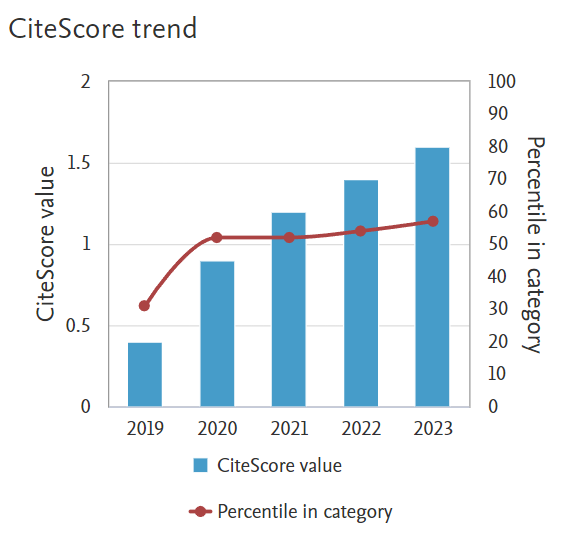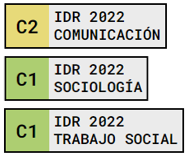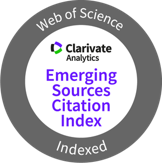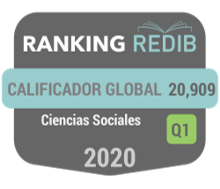Neurocomunicación y discapacidad. En búsqueda de la igualdad y la inclusión
Palabras clave:
Neuromarketing, discapacidad, igualdad, inclusión, revisión sistemática, técnicas de neurocomunicaciónResumen
El neuromarketing estudia los procesos de toma de decisiones de los consumidores, antes, durante y después de la compra. Los especialistas pueden analizar la actividad cerebral de los consumidores y comprender cómo reaccionan a diferentes estímulos. Los críticos defienden que puede ser utilizado para manipular a los consumidores, que las empresas deberían ser más éticas en su uso de estas técnicas y que tiene profundas limitaciones en su análisis con personas discapacitadas. Sin embargo, las posibilidades son mayores que las limitaciones y el neuromarketing puede tener aplicaciones interesantes y positivas en el contexto de la discapacidad. Como estos avances innovadores todavía ocupan poco espacio en los textos académicos, este trabajo tiene el objetivo principal de conocer el estado de la cuestión en neuromarketing y discapacidad para determinar las teorías, ideas y conceptos principales. Para ello se lleva a cabo una investigación de síntesis con el Framework SALSA, bajo la modalidad de scoping review, sin límite temporal, en 6 bases de datos: Scopus, Web of Science, Google Scholar, Microsoft Academic (inglés), Dialnet Plus y Bases de datos del CSIC (español). Los hallazgos reflexionan sobre las herramientas útiles para todas las personas, con y sin discapacidad, que ayudan a la plena igualdad e inclusión. Entre los retos de futuro se encuentran las limitaciones de la técnica que dependen de capacidades sensoriales; los diferentes patrones de actividad cerebral de las personas con alguna discapacidad; y la necesidad de nuevos enfoques y técnicas en otras áreas sensoriales (tacto y gusto).
Descargas
Citas
Abuín-Penas, J., & Abuín-Penas, R. (2022). Social media and interest in official information in times of pandemic: analysis of the communication of the European ministries of health on Facebook during covid-19. Revista de Comunicación y Salud, 12, 59-76. https://doi.org/10.35669/rcys.2022.12.e303
Adewunmi, Y., Chigbu, U. E., Mwando, S., & Kahireke, U. (2023). Entrepreneurship role in the co-production of public services in informal settlements. A scoping review. Land use policy: The International Journal Covering all Aspects of Land Use, 125, 106479. https://doi.org/10.1016/j.landusepol.2022.106479
Alonso-Miñón Muñoz, L. (2024). Análisis longitudinal de sistemas Brain-Computer Interface (BCI) no invasivos basados en potenciales evocados modulados por código (c-VEP) con electrodos secos y húmedos. [Bachelor’s degree] Universidad de Valladolid. https://uvadoc.uva.es/handle/10324/71284
Alsharif, A., Salleh, N. Z., Hashem, A. R., Khraiwish, A., Putit, L., & Arif, L. S. M. (2023). Exploring factors influencing neuromarketing implementation in Malaysian Universities: Barriers and enablers. Sustainability, 15(5), 4603. https://doi.org/10.3390/su15054603
Álvarez Sigüenza, J. F. (2024). La publicidad subliminal: Análisis del riesgo de su presencia en los medios de comunicación. European Public & Social Innovation Review, 9, 1–19. https://doi.org/10.31637/epsir-2024-1076
Anuja, A. K., Pallavi, S., & Pandey, S. C. (2024). Advances in Sentiment and Emotion Analysis Techniques. Health Leadership and Quality of Life, 3(399), 1-7. https://doi.org/10.56294/hl2024.399
Barrientos-Báez, A., Báez-García, A., Flores-Muñoz, F., & Gutiérrez-Barroso, J. (2018). Gender diversity, corporate governance, and firm behaviour: The challenge of emotional management. European Research on Management and Business Economics, 24(3), 121-129. https://doi.org/10.1016/j.iedeen.2018.07.001
Barrientos-Báez, A., & Caldevilla-Domínguez, D. (2019). Public Relations and Neurocommunication as tools for improving the brand image of public characters. Revista de Ciencias de la Comunicación e Información, 24(1), 1-13. https://doi.org/10.35742/rcci.2019.24(1).1-13
Barrientos-Báez, A., Martínez-Sala, A. M., & Altamirano-Benítez, V. (2022). Covid-19, a Myth in Tourism Communication. Analysis of the Contents Generated by Tourist Influencers 2.0 about the Pandemic and Destinations. Palabra Clave, 25(1), e2518. https://doi.org/10.5294/pacla.2022.25.1.8
Bernal-Camargo, D. R., Díaz Amado, E., & Padilla Muñoz, A. C. (2017). Ethical Challenges of the Socio-Juridical Research: Review from Good Practices in Published Articles. Estudios Socio-Jurídicos, 20(1), 107-131. https://doi.org/10.12804/revistas.urosario.edu.co/sociojuridicos/a.6043
Bhardwaj, S., Rana, G., Behl, A., & Gallego de Cáceres, S. J. (2023). Exploring the boundaries of Neuromarketing through systematic investigation. Journal of Business Research, 154, 1-14. https://doi.org/10.1016/j.jbusres.2022.113371
Blas Riesgo, S., Moreno Moreno, E., & Portilla, I. (2019). Live political events on Twitter: The case of the 2015 Election Night in Spain. Miguel Hernández Communication Journal, 10(1), 123-145. http://dx.doi.org/10.21134/mhcj.v10i0.281
Booth, A., Sutton, A., & Papaionnou, D. (2012). Systematic Approaches to a Successful Literature Review. London: SAGE.
Brasales Amores, E. J., & Proaño Mariño, B. F. (2025). Desarrollo de una interfaz cerebro-computadora de adquisición y procesamiento de señales EEG para proporcionar una vía de comunicación básica en personas con síndrome de Angelman mediante el asistente personal inteligente Alexa [Bachelor's thesis] Universidad de Riobamba. http://dspace.unach.edu.ec/handle/51000/14684
Brunner, P., Bianchi, L., Guger, C., Cincotti, F., & Schalk, G., (2011). Current trends in hardware and software for brain-computer interfaces (BCIs). Journal of Neural Engineering, 8, 025001. https://doi.org/10.1088/1741-2560/8/2/025001
Bullock-Palmer, R. P., Einstein, A. J., & Srichai, M. B. (2024). How cardiac computed tomography angiography and positron emission tomography play complementary roles in a Practice's business model. Journal of Cardiovascular Computed Tomography 19(1), 139-148. https://doi.org/10.1016/j.jcct.2024.11.003
Capone, V., Bartoli, C., Mattiacci, A., & Cherubino, P. (2024). Consumer Reactions to Generative AI: An Exploratory Study Using Neuroscientific Techniques. In F. J. Martínez-López, L. F. Martínez & P. Brüggemann (Eds.), Digital Marketing & eCommerce Fifth International Conference, 2024 (pp. 54-62). Springer.
Cardoso, L., Chen, M.-M., Araújo, A. F., de Almeida, G. G. F., Dias, F., & Moutinho, L. (2022). Accessing Neuromarketing Scientific Performance: Research Gaps and Emerging Topics. Behavioural Sciences, 12(2), 55. https://doi.org/10.3390/bs12020055
Castañeda Pérez, J. (2024). Efectos de la publicidad invasiva de YouTube en el comportamiento del consumidor de estudiantes universitarios. [Degree Thesis] Universidad Católica Santo Toribio de Mogrovejo. https://shorturl.at/o3Xgj
Cerdá-Suárez, L. M., Cristófol-Rodríguez, C., & Lafuente Aliaga, I. (2021). Music in accessible experiential events for the deaf. Evidence from the Young Music Fest 2019 case. Prisma Social, 36, 65-87. https://revistaprismasocial.es/article/view/4581
Cenizo, C. (2024). Estrategias de fijación ocular y amor hacia la marca: influencia del género en la generación Z. Revista de Comunicación de la SEECI, 57, 1-37. https://doi.org/10.15198/seeci.2024.57.e893
Cherubino, P., Martínez-Levy, A. C., Caratù, M., Cartocci, G., Di Flumeri, G., Modica, E., Rossi, D., Mancini, M., & Trettel, A. (2019). Consumer behaviour through the eyes of neurophysiological measures: State-of-the-art and future trends. Computational Intelligence and Neuroscience, 1976847. https://doi.org/10.1155/2019/1976847
Chhimpa, G. R., Kumar, A., Garhwal, S., & Dhiraj. (2024). Empowering individuals with disabilities: a real-time, cost-effective, calibration-free assistive system utilizing eye tracking. Journal of Real-Time Image Processing, 21(3), 97. https://doi.org/10.1007/s11554-024-01478-w
Ching-Ruíz, Y. E., Ching-Ruíz, K. D. C., & Espinosa Fernández, E. (2024). Neuromarketing: cuando la ciencia seduce la mente del consumidor. Synergia, 3(2), 306-322. https://revistas.up.ac.pa/index.php/synergia/article/view/6214/4745
Codina, L. (2017). Bases de datos académicas para investigar en Comunicación Social: revisiones sistematizadas, grupo óptimo y protocolo de búsqueda. PortalComunicación.com. https://acortar.link/G8nNm6
Codina, L. (2024). Principios para realizar revisiones sistemáticas de calidad: scoping reviews con frameworks PRISMA y SALSA. Repositori.upf.edu. http://hdl.handle.net/10230/58971
Crista, M. J. S., Torres, P., Príncipe, F., & Mota, L. (2023). Fatores psicossociais de inclusão do doente em cirurgia ambulatória: scoping review. Millenium. Journal of Education, Technologies and Health, 2(20), 1-6, e27266. https://doi.org/10.29352/mill0220.27266
Cristófol-Rodríguez, C., Porras-Florido, C., Cerdá-Suárez, L. M., & Mocchi, B. (2024). Neuromarketing y moda: una revisión sistemática sobre sus implicaciones sensoriales. Revista de Ciencias de la Comunicación e Información, 29. https://doi.org/10.35742/rcci.2024.29.e304
Day, R. A. (2005). Cómo escribir y publicar trabajos científicos. OPS.
Del-Ponti, P., Barrientos-Báez, A., & Caldevilla-Domínguez, D. (2022). City Branding: communication and marketing strategy for an island urban policy. Revista Mediterránea de Comunicación, 13(1), 317-329. https://www.doi.org/10.14198/MEDCOM.19758
Díaz-Altozano, P., Padilla-Castillo, G., & Requeijo-Rey, P. (2021). Girls’s sexualization on social networks: the need for semantic intelligence on Instagram. Investigaciones Feministas, 12(1), 31-45. https://doi.org/10.5209/infe.69559
Edelman, B. J., Zhang, S., Schalk, G., Brunner, P., Müller-Putz, G., Guan, C., & He, B. (2024). Non-invasive brain-computer interfaces: state of the art and trends. IEEE Reviews in Biomedical Engineering 18, 26-49. https://doi.org/10.1109/RBME.2024.3449790
Feenstra, R., & Pallarés-Domínguez, D. (2017). Ethical debates on political neuromarketing: the technological advance and its potential impact on the formation of public opinion. Veritas, 36, 9-28. http://dx.doi.org/10.4067/S0718-92732017000100001
Fondón Ludeña, A. (2025). Emociones, consumo y bienestar subjetivo: Análisis de las compras con sentimiento. European Public & Social Innovation Review, 10, 1-13. https://doi.org/10.31637/epsir-2025-1407
Gálvez-Toro, A. (2001). Enfermería Basada en la Evidencia. Cómo incorporar la investigación a la práctica de los cuidados. Fundación Índex.
García-Erviti, N. (2024). Análisis de la efectividad publicitaria online: Investigación desde la perspectiva del neuromarketing (Doctoral dissertation. Facultad de Ciencias Económicas y Empresariales) UDIMA. https://shorturl.at/i0xoj
González-Oñate, C., Mayo Alcaraz, M., & Maldonado García, L. (2025). El Storytelling como estrategia de comunicación: Un caso aplicado a los spots de Lotería de Navidad. Revista Prisma Social, 48, 6–26. https://revistaprismasocial.es/article/view/5662
Grant, M., & Booth, A. (2009). A typology of reviews: an analysis of 14 review types and associated methodologies. Health Information and Library Journals, 26(2), 91-108. https://doi.org/10.1111/j.1471-1842.2009.00848.x
Guamán Chuquitarco, E. E., & Minta Jami, A. I. (2024). Desarrollo de una interfaz cerebro-computador para control y activación del manipulador robótico KUKA KR10R900 mediante señales cerebrales. [Curricular Integration Work] Escuela Superior Politécnica de Chimborazo. http://dspace.espoch.edu.ec/handle/123456789/23030
Hensel, D., Iorga, A., Wolter, L., Znanewitz, J., & Briesemeister, B. (2017). Conducting neuromarketing studies ethically-practitioner perspectives. Cogent Psychology, 4(1), 1320858. https://doi.org/10.1080/23311908.2017.1320858
Javor, A., Koller, M., Lee, N., Chamberlain, L., & Ransmayr, G. (2023). Neuromarketing and consumer neuroscience: contributions to neurology. BMC Neurology, 13(13), 1-12. https://acortar.link/G8nNm6
Kaklauskas, A., Abraham, A., Ubarte, I., Kliukas, R., Luksaite, V., Binkyte-Veliene, A., Vetloviene, I., & Kaklauskiene, L, (2002). A review of AI cloud and edge sensors, methods, and applications for the recognition of emotional, affective, and physiological states. Sensors, 22, 7824. https://doi.org/10.3390/s22207824
Libert, A., & Van Hulle, M. (2019). Predicting Premature Video Skipping and Viewer Interest from EEG Recordings. Entropy, 21, 1014. https://doi.org/10.3390/e21101014
López-Ornelas, M. (2024). Estudio cuantitativo de los procesos de comunicación de Revista Latina de Comunicación Social (RLCS), 1998-2009. Revista Latina de Comunicación Social, 65, 538-552. https://doi.org/10.4185/rlcs-2010-1079
Lopezosa, C., Guallar, J., Codina, L., & Pérez-Montoro, M. (2023). Content curation and journalism: exploratory scoping review and expert opinion. Revista Mediterránea de Comunicación, 14(1), 205-223.
https://www.doi.org/10.14198/MEDCOM.22810
Machi, L., & McEvoy, B. (2009). The literature review: six steps to success. Sage.
Matarín Rodríguez-Peral, E., Gómez Franco, T., & García Manso, A. (2022). Application of the Analytical Hierarchical Process in the digital communication of public agencies during the covid-19 pandemic. Revista Latina de Comunicación Social, 80, 89-117. https://doi.org/10.4185/RLCS-2022-1532
Matos Agudo, D., Rubio Gil, F. J., Nieto Manibardo, E., Rey García, P., & Gómez Sánchez, J. C. (2024). Estudio cualitativo de los intercambios comunicativos en la asistencia sanitaria hospitalaria a través de los estudiantes del grado de Medicina. Revista de Comunicación y Salud, 15, 1-18. https://doi.org/10.35669/rcys.2025.15.e373
McPhail, R., Chan, X. W., May, R., & Wilkinson, A. (2024). Post-COVID remote working and its impact on people, productivity, and the planet: an exploratory scoping review. The International Journal of Human Resource Management, 35(1), 154-182. https://doi.org/10.1080/09585192.2023.2221385
Montiel Torres, M. F., & Teruel Rodríguez, L. (2024). Verificadoras. Mujeres en iniciativas de verificación en los países del sur de la Unión Europea. Vivat Academia, 158, 1-22. https://doi.org/10.15178/va.2025.158.e1548
Moreno-Moreno, E., & Sanjurjo-San-Martín, E.-L. (2020). Selective consumption of news brands in Spain: trust, political leaning, and degree of digital consumption. Profesional de la Información, 29(5), 1-13. https://doi.org/10.3145/epi.2020.sep.24
Núñez-Gómez, P., Álvarez-Ruiz, A., Ortega-Mohedano, F., & Álvarez-Flores, E. (2020). Neuromarketing highlights in how Asperger syndrome youth perceive advertising. Frontiers in Psychology, 11, 2103. https://doi.org/10.3389/fpsyg.2020.02103
Padilla-Castillo, G. (2023). “The Melancholy Bubble”. Emotional dangers in social media. Human Review, 16(6), 1-10. https://doi.org/10.37467/revhuman.v12.4703
Patiño Mazo, E. A. (2024). Caracterización del Marketing Mix: una revisión sistemática de la literatura académica entre 1960 y 2023. Vivat Academia, 157. https://doi.org/10.15178/va.2024.157.e1519
Polat, K., Bilal Aygun, A., & Kavsaoglu, A. R. (2021). EEG based brain-computer interface control applications: A comprehensive review. Journal of Bionic Memory, 1(1), 20-33. http://jbionicmemory.com/index.php/jbm/article/view/4
Popa, L., Selejan, O., Scott, A., Mure?anu, D., Balea, M., & Rafila, A. (2015). Reading beyond the glance: eye tracking in neurosciences. Neurological Sciences, 36, 683-688. https://acortar.link/rSXLjc
Sáez García, J. (2024). Análisis del Comportamiento Visual y Fisiológico durante el Proceso de Aprendizaje: un enfoque desde la Ingeniería de la Salud. [Bachelor's thesis] Universidad de Burgos.
Sánchez Blanco, C. (2009). Génesis de la planificación de cuentas: cómo gestionar el conocimiento del consumidor en las agencias de Publicidad. Communication & Society, 22(2), 187-219. https://shorturl.at/zR4mO
Saposnik, G., & Johnston, C. (2014). Decision Making in Acute Stroke Care. Learning From Neuroeconomics, Neuromarketing, and Poker Players. Stroke, 45(7), 2144-2150. https://doi.org/10.1161/STROKEAHA.114.005462
Sindhuja, S., & Malik, R. (2024). Exploring the Ethical Issues and Considerations in Neuromarketing. In R. Malik, S. Malhan & M. Arora (Coords.) Sensible Selling Through Sensory Neuromarketing (pp. 144-163). IGI Global.
Soufineyestani, M., Dowling, D., & Khan, A. (2020). Electroencephalography (EEG) Technology Applications and Available Devices. Applied Sciences, 10, 7453. https://doi.org/10.3390/app10217453
Tajahuerce Ángel, I., & Padilla Castillo, G. (2015). Gender policies on media. What exists and what should exist to regulate the content and the language of Journalism information. Revista de Comunicación de la SEECI, 37, 169-210. https://doi.org/10.15198/seeci.2015.37.169-210
Unal, H. P., Gokmen, G., & Yumurtaci, M. (2020). Emotion Classification with DEAP Dataset: Survey. Conference: 2020 Innovations in Intelligent Systems and Applications Conference (ASYU). https://doi.org/10.1109/ASYU50717.2020.9259797
Valderrama, C. E., & Ulloa, G. (2011). Spectral analysis of physiological parameters for consumers' emotion detection. Revista Sistemas y Telemática, 10(20), 27-49. https://doi.org/10.18046/syt.v10i20.1148
Yadav, D., Yadav, S., & Veer, K. (2021). Trends and Applications of Brain Computer Interfaces. Current Signal Transduction Therapy, 16(3), 211-223. https://doi.org/10.2174/1574362415999201124224606
Descargas
Publicado
Cómo citar
Número
Sección
Licencia
Derechos de autor 2025 Revista Prisma Social

Esta obra está bajo una licencia internacional Creative Commons Atribución-NoComercial-SinDerivadas 4.0.
Los autores/as que publiquen en esta revista aceptan las siguientes condiciones:
- Los autores/as conservan los derechos de autor.
- Los autores/as ceden a la revista el derecho de la primera publicación. La revista también posee los derechos de edición.
- Todos los contenidos publicados se regulan mediante una Licencia Atribución/Reconocimiento-SinDerivados 4.0 Internacional. Acceda a la versión informativa y texto legal de la licencia. En virtud de ello, se permite a terceros utilizar lo publicado siempre que mencionen la autoría del trabajo y a la primera publicación en esta revista. Si transforma el material, no podrá distribuir el trabajo modificado.
- Los autores/as pueden realizar otros acuerdos contractuales independientes y adicionales para la distribución no exclusiva de la versión del artículo publicado en esta revista (p. ej., incluirlo en un repositorio institucional o publicarlo en un libro) siempre que indiquen claramente que el trabajo se publicó por primera vez en esta revista.
- Se permite y recomienda a los autores/as a publicar su trabajo en Internet (por ejemplo en páginas institucionales o personales), una vez publicado en la revista y citando a la misma ya que puede conducir a intercambios productivos y a una mayor y más rápida difusión del trabajo publicado (vea The Effect of Open Access).


















